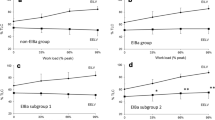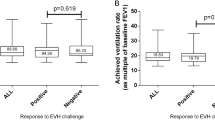Abstract
To study the relationship of bronchoconstriction and refractoriness we performed pairs of exercise and hyperventilation tests in 15 patients (mean [SEM] age 28.5 [2.8] years) with a history of exercise-induced asthma. Mean (SEM) maximum specific airway resistance (SRaw) increased during the first exercise test to 33.9 (4.5) and during the second exercise test to 29.8 (5.2) cmH2O×s (n.s.). Mean (SEM) maximum specific airway resistance (SRaw) increased during the first hyperventilation test to 44.0 (5.9) and during the second hyperventilation test to 27.4 (3.3) cmH2O×s (p<0.01). Mean maximum bronchoconstriction after corresponding exercise and hyperventilation tests did not differ statistically. There was a significantly larger interindividual variability in the airway response to hyperventilation (p<0.001). From these data we suggest that similar refractoriness can be observed after both exercise and hyperventilation.
Similar content being viewed by others
References
Anderson SD (1985) Issues in exercise-induced asthma. J Allergy Clin Immunol 76:763–772
Assoufi A, Dally MB, Newman-Taylor AJ, Denison DM (1986) Cold air test: a simplified standard method for airway reactivity. Bull Eur Physiopathol Respir 22:349–357
Barnes P, Brown M, Silverman M, Dollery C (1981) Circulating catecholamines in exercise- and hyperventilation-induced asthma. Thorax 36:435–440
Barnes P, Brown MJ (1981) Venous histamine in exercise- and hyperventilation-induced asthma in man. Clin Sci 61:159–162
Bar-Or O, Neumann I, Dotan R (1977) Effects of dry and humid climates on exercise-induced asthma in children and preadolescents. J Allergy Clin Immunol 60:163–168
Bar-Yishay E, Ben-Dov I, Godfrey S (1983) Refractory period after hyperventilation-induced asthma. Am Rev Respir Dis 127:572–574
Bascom R, Bleecker ER (1986) Bronchoconstriction induced by distilled water. Sensitivity in asthmatics and relationship to exercise-induced bronchospasm. Am Rev Respir Dis 134:248–253
Belcher NG, Rees PJ, Clark TJH, Lee T (1987) A comparison of the refractory periods induced by hypertonic airway challenge and exercise in bronchial asthma. Am Rev Respir Dis 135:822–825
Belcher NG, Lee TH, Rees PJ (1989) Airway responses to hypertonic saline, exercise and histamine challenges in bronchial asthma. Eur Respir J 2:44–48
Ben-Dov I, Bar-Yishay E, Godfrey S (1982) Refractory period after exercise-induced asthma unexplained by respiratory heat loss. Am Rev Respir Dis 125:530–534
Ben-Dov I, Gur I, Bar-Yishay E, Godfrey S (1983) Refractory period following induced asthma: contributions of exercise and isocapnic hyperventilation. Thorax 38:849–853
Bonnet R, Jörres R, Heitmann U, Magnussen H (1990) Relationship between circadian variations of airway tone and airway responsiveness in bronchial asthma. Am Rev Respir Dis 141:A358
Deal EC Jr, McFadden ER Jr, Ingram RH Jr, Strauss RH, Jaeger JJ (1979) Role of respiratory heat exchange in production of exercise-induced asthma. J Appl Physiol 46:467–475
Deal EC Jr, McFadden ER Jr, Ingram RH Jr, Breslin FJ, Jaeger JJ (1980) Airway responsiveness to cold air and hyperpnea in normal subjects and in those with hay fever and asthma. Am Rev Respir Dis 121:621–628
DuBois AB, Botelho WSY, Bedell GN, Marshall R, Comroe JH Jr (1956) A rapid plethysmographic method for measuring thoracic gas volume: a comparison with a nitrogen washout method for measuring functional residual capacity in normal subjects. J Clin Invest 35:322–326
Edmunds A, Tooley M, Godfrey S (1978) The refractory period after exercise-induced asthma: the duration and relation to the severity of exercise. Am Rev Respir Dis 117:247–254
Eschenbacher WL, Sheppard D (1985) Respiratory heat loss is not the sole stimulus for bronchoconstriction induced by isocapnic hyperpnea with cold air. Am Rev Respir Dis 131:894–901
Florentin D, Dessanges JR, Marsac J, Lockhart A (1984) Reappraisal of the refractory period after hyperventilation-induced asthma. Clin Sci 67:59
Gilbert IA, Fouke JM, McFadden ER (1987) Heat and water flux in the intrathoracic airways and exercise-induced asthma. J Appl Physiol 63:1681–1691
Gilbert JA, Fouke JM, McFadden ER Jr (1988) Intra-airway thermodynamics during exercise and hyperventilation in asthmatics. J Appl Physiol 64:2167–2174
Heaton RW, Henderson AF, Gray BJ, Costello JF (1983) The bronchial response to cold air challenge: evidence for different mechanisms in normal and asthmatic subjects. Thorax 38:506–511
Ingram RH Jr, McFadden ER Jr (1983) Are exercise and isocapnic voluntary hyperventilation identical bronchial provocations? Eur J Respir Dis 64 (suppl. 128):242–245
James L, Faciane J, Sly RM (1976) Effect of treadmill exercise on asthmatic children. J Allergy Clin Immunol 57:408–416
Lee T, Nagakura T, Cromwell O, Brown M, Causon R, Kay A (1984) Neutrophil chemotactic activity and histamine in atopic and nonatopic subjects after exercise-induced asthma. Am Rev Respir Dis 129:409–412
Magnussen H, Scheidt-Mackes M, Kesseler KH (1983) Körperliche Belastung und Hyperventilation als auslösende Faktoren der Atemwegsobstruktion beim Asthma bronchiale. Prax Klin Pneumol 37:685–686
Magnussen H, Reuss G, Jörres R (1986) Airway response to methacholine during exercise induced refractoriness in asthma. Thorax 41:667–670
Magnussen H, Reuss G, Jörres R (1988) Methylxanthines inhibit exercise-induced bronchoconstriction at low serum theophylline concentration and in a dose-dependent fashion. J Allergy Clin Immunol 81:531–537
Malo J-L, Cartier A, L’Archevéque J, Ghezzo H, Martin RR (1986) Cold air inhalation has a cumulative bronchospastic effect when inhaled in consecutive doses for progressively increasing degrees of ventilation. Am Rev Respir Dis 134:990–993
Margolskee DJ, Bigby BG, Boushey HA (1988) Indomethacin blocks airway tolerance to repetitive exercise but not to eucapnic hyperpnea in asthmatic subjects. Am Rev Respir Dis 137:842–846
McNeill RS, Nairn JR, Millar JS, Ingram CG (1965) Exercise-induced asthma. Q J Med 35:55–67
Noviski N, Bar-Yishay E, Gur I, Godfrey S (1988) Respiratory heat/water loss alone does not determine the severity of exercise-induced asthma. Eur Respir J 1:253–256
O’Connor GT, Sparrow D, Weiss ST (1989) The role of allergy and nonspecific airway hyper-responsiveness in the pathogenesis of chronic obstructive pulmonary disease. Am Rev Respir Dis 140:225–252
Rakotosihanaka F, Melaman F, d’Athis P, Florentin D, Dessanges JF, Lockhart A (1986) Refractoriness after hyperventilation-induced asthma. Bull Eur Physiopathol Respir 22:581–587
Rosenthal RR, Laube BL, Hood DB, Norman PS (1990) Analysis of refractory period after exercise and eucapnic voluntary hyperventilation challenge. Am Rev Respir Dis 141:368–372
Sachs L (1984) Angewandte Statistik, 6th ed. Berlin, Springer.
Schnall RP, Landau LI (1980) Protective effect of repeated short sprints in exercise-induced asthma. Thorax 35:828–832
Schoeffel RE, Anderson SD, Lindsay DA (1980) Multiple exercise and histamine challenges in asthmatic patients. Thorax 35:164–170
Sheppard D, Eschenbacher WL (1984) Respiratory water loss as a stimulus to exercise-induced bronchoconstriction. J Allergy Clin Immunol 73:640–643
Stearns DR, McFadden ER, Breslin FJ, Ingram RH (1981) Reanalysis of the refractory period in exertional asthma. J Appl Physiol 50:503–508
Strauss RH, McFadden ER, Ingram RH, Deal E, Jaeger J (1978) Influence of heat and humidity on the airway obstruction induced by exercise in asthma. J Clin Invest 61:433–440
Tal A, Pasterkamp H, Serrette C, Leahy F, Chernick V (1984) Response to cold air hyperventilation in normal and in asthmatic children. J Pediatr 104:516–521
Tessier P, Cartier A, L’Archevéque J, Ghezzo H, Martin RR, Malo JL (1986) Within- and between-day reproducibility of isocapnic cold air challenges in subjects with asthma. J Allergy Clin Immunol 78:379–387
van Aalderen WMC, Postma DS, Koeter GH, Knol K (1989) Circadian change in bronchial responsiveness and airflow obstruction in asthmatic children. Thorax 44:803–807
Wiebicke W, Poynter A, Montgomery M, Chernick V, Pasterkamp H (1988) Effect of terfenadine on the response to exercise and cold air in asthma. Pediatr Pulmonol 4:225–229
Wilson NM, Barnes PJ, Vickers H, Silverman M (1982) Hyperventilation-induced asthma: evidence for two mechanisms. Thorax 37:657–662
Author information
Authors and Affiliations
Rights and permissions
About this article
Cite this article
Nowak, D., Kuziek, G., Jörres, R. et al. Comparison of refractoriness after exercise-and hyperventilation-induced asthma. Lung 169, 57–67 (1991). https://doi.org/10.1007/BF02714143
Accepted:
Issue Date:
DOI: https://doi.org/10.1007/BF02714143




